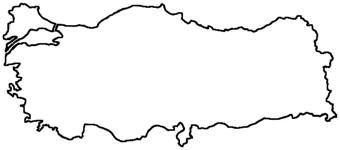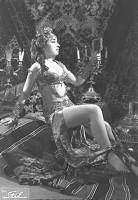
|
The Society of Folk Dance Historians (SFDH)
Turkish Culture and Dances
[
Home |
About |
Encyclopedia | CLICK AN IMAGE TO ENLARGE |

|
 In Turkish folkore there are a few characters who are known to all. One of these is Nasreddin Hoca. Storytellers through the years have told us of his adventures, starting each story with "One day Hoca . . ." Although Hoca appears to be a fool, in truth he demonstrates the foolishness of those he encounters in his adventures. Two other well known characters are Karagöz and Hacivat. They were workers in the Bursa Ulu Mosque who were condemned to death for the jokes they made. It seems that the sultan was concerned that the jokes, which spoke of the abuses of power, were dangerous to the stability of the sultanate. The jokes, however, were not forgotten, nor were the two workers. Over time, Karagö and Hacivat became the first subjects of the Turkish shadow puppet theater.
In Turkish folkore there are a few characters who are known to all. One of these is Nasreddin Hoca. Storytellers through the years have told us of his adventures, starting each story with "One day Hoca . . ." Although Hoca appears to be a fool, in truth he demonstrates the foolishness of those he encounters in his adventures. Two other well known characters are Karagöz and Hacivat. They were workers in the Bursa Ulu Mosque who were condemned to death for the jokes they made. It seems that the sultan was concerned that the jokes, which spoke of the abuses of power, were dangerous to the stability of the sultanate. The jokes, however, were not forgotten, nor were the two workers. Over time, Karagö and Hacivat became the first subjects of the Turkish shadow puppet theater.
Central to Turkish life is the kahve (coffee house), found in every village. Once, the men of the village would solve the problems of the world while enjoying the nargile (hukkah or bubble pipe). Another institution of Turkish life is the hamam (Turkish baths). The baths combine the importance placed on cleanliness with the respect for the use of water. The baths grew to be a place where people of all classes in Turkish society could mingle, where important life occasions, such as the bathing of the bride before marriage, bathing of the soldier before going into the army, and the newborn's birth, were celebrated. Hospitality bathing is common, where a host takes his guest to the hamam, as hospitality is honored in Turkish life. The guest is always welcomed in the home, and the best foods are offered to the guest.
 In Turkey, you will see that people wear a boncuk (magic stone to protect from the "evil eye"). This tradition started with the legend of the rock at the sea that no one could move. A man, Nazar, was called, who had the evil eye and when he looked at the rock, it cracked into two pieces. People continue to fear the evil eye, and speak of any disaster as coming from the evil eye. By wearing the boncuk, people believe they are protecting themselves from danger.
In Turkey, you will see that people wear a boncuk (magic stone to protect from the "evil eye"). This tradition started with the legend of the rock at the sea that no one could move. A man, Nazar, was called, who had the evil eye and when he looked at the rock, it cracked into two pieces. People continue to fear the evil eye, and speak of any disaster as coming from the evil eye. By wearing the boncuk, people believe they are protecting themselves from danger.
TURKISH DANCES
 There are particular dances for many events, such as weddings, harvest, and for guest welcoming. Here are some of the many, varied dances of the Turkish people:
There are particular dances for many events, such as weddings, harvest, and for guest welcoming. Here are some of the many, varied dances of the Turkish people:
Horon, a very fluid and swift dance, is performed by men only, dressed in black with silver trimmings. The dancers link arms and quiver to the vibrations of the kemençe (a primitive violin particular to the Black Sea Region).
Kılıç Kalkan is practiced in Bursa in memory of the capture of the city by the Ottomans. It is performed by men only, dressed in early Ottoman battle dress, who dance to the sound of clashing swords and shields without music.
Zeybek, particular to the Aegean region, symbolizes courage and heroism. This dance is performed by Efe, colorfully dressed male dancers.
Kaşık Oyunu is performed by men and women who dance together in many dances. The dance consists of gaily dressed male and female dancers clicking out the dance rhythm with a pair of wooden spoons in each hand, and is performed from Konya to Silifike.
Aysat is from Kars, one of the easternmost cities of Turkey. It is a romantic dance of classical nature. The dances of Eastern Anatolia (Artvin and Kars) are generally performed at celebratory events, such as marriages. The women are in red and white dresses with chiffon scarves hanging from their heads. The men wear military style uniforms representative of the military strife throughout their history during the early twentieth century.
 Galuç is a dance from the Hallun village of Kâhta in Adıyaman province and depicts the struggle of the villagers fighting a poisonous weed called geliç. Adıyaman is located between the upper Euphrates River of eastern and the middle Euphrates River of southeastern Turkey. Folk dances of this region usually depict daily life or cultivation of the land. The music for the dances is usually provided by a davul (large drum) and a zurna (Turkish oboe). Village men get up early in the mornings before planting season to eradicate gelliç from the fields. At noon, the women bring their lunch in buckets and water in gourds. After the lunch is consumed, men get back to work. When finally the field is cleared of the weed, men celebrate the occasion by performing the dance. Women join them, too. Women carry the gourds on their shoulders during the dance and men go through symbolic motion of chopping the weed with their sicles.
Galuç is a dance from the Hallun village of Kâhta in Adıyaman province and depicts the struggle of the villagers fighting a poisonous weed called geliç. Adıyaman is located between the upper Euphrates River of eastern and the middle Euphrates River of southeastern Turkey. Folk dances of this region usually depict daily life or cultivation of the land. The music for the dances is usually provided by a davul (large drum) and a zurna (Turkish oboe). Village men get up early in the mornings before planting season to eradicate gelliç from the fields. At noon, the women bring their lunch in buckets and water in gourds. After the lunch is consumed, men get back to work. When finally the field is cleared of the weed, men celebrate the occasion by performing the dance. Women join them, too. Women carry the gourds on their shoulders during the dance and men go through symbolic motion of chopping the weed with their sicles.
Turkish Belly Dance today may have been influenced by Roma people. As Turkish law does not impose restrictions on Turkish dancers' movements and costuming (as in Egypt, where dancers are prevented from performing floor work and certain pelvic movements), Turkish dancers are often more outwardly expressive than their Egyptian sisters. Many professional dancers and musicians in Turkey continue to be of Romani heritage as well. It should be noted, however, that people of Turkish Romani heritage also have a distinct dance style that is uniquely different from the Turkish Oriental style. Turkish dancers are known for their energetic, athletic, and even gymnastic style, and particularly, until the past few years, their adept use of zils (finger cymbals). Connoisseurs of Turkish dance often say that a dancer who cannot play the zils is not an accomplished dancer. Turkish belly dance costumes can be very revealing, with the belt sometimes worn high up on the waist and split skirts that expose the entire leg, although dancers today are costuming themselves more like Egyptian dancers and wearing more modest "mermaid-style" skirts. The Turkish style is emphasized further by the dancer wearing high heels and often platform shoes, rather than dancing barefooted.
As in so many cultures, dance is an integral part of life in Turkey. It is a means of celebration, of marking life's milestones, of expressing the trials of daily life, of remembering history, and simply an expression of joy.
DOCUMENTS
- Dancing in Turkey, an article.
- Turkey, a country.
- Turkish Folk Dance, an article.
- Turkish Folk Dance Origins, and article.
- Turkish History Through Folk Dance, an article.
Printed in Folk Dance Scene, September 2007.
This page © 2018 by Ron Houston.
Please do not copy any part of this page without including this copyright notice.
Please do not copy small portions out of context.
Please do not copy large portions without permission from Ron Houston.